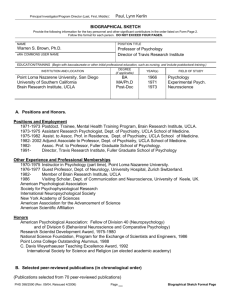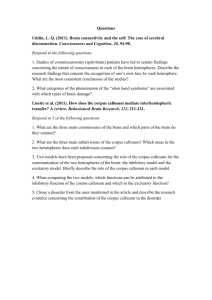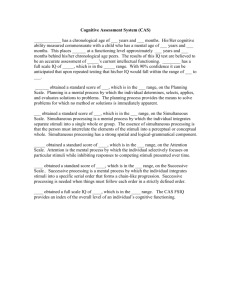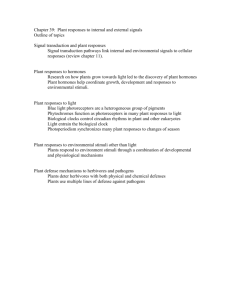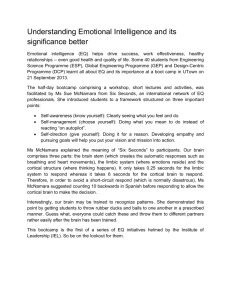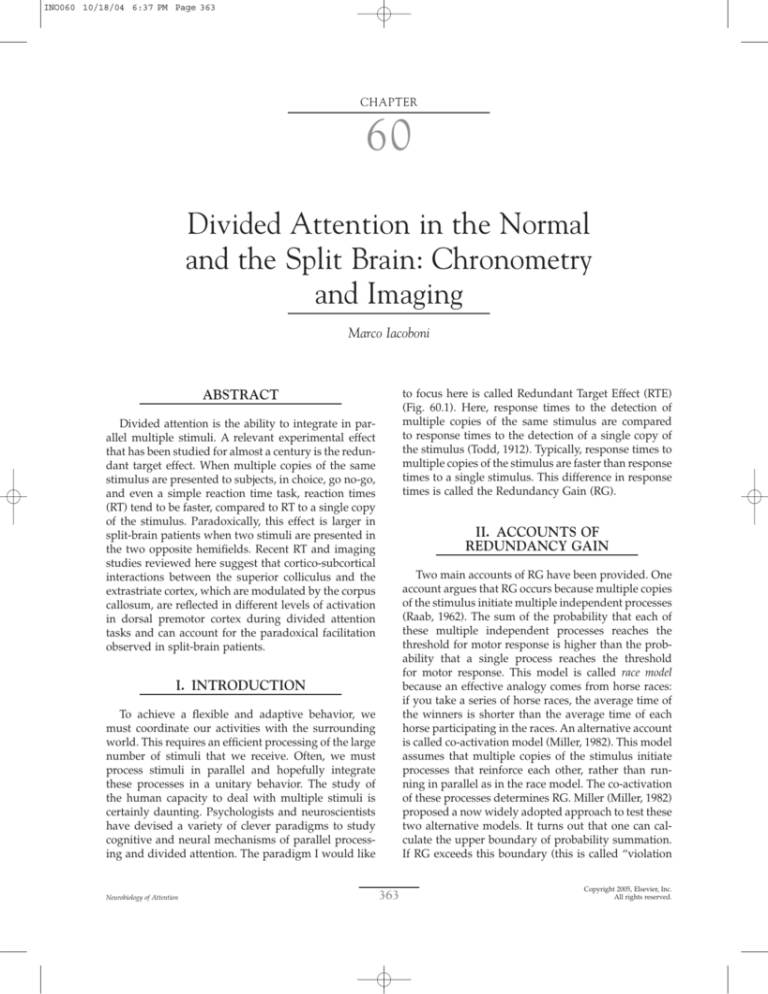
INO060 10/18/04 6:37 PM Page 363
CHAPTER
60
Divided Attention in the Normal
and the Split Brain: Chronometry
and Imaging
Marco Iacoboni
ABSTRACT
to focus here is called Redundant Target Effect (RTE)
(Fig. 60.1). Here, response times to the detection of
multiple copies of the same stimulus are compared
to response times to the detection of a single copy of
the stimulus (Todd, 1912). Typically, response times to
multiple copies of the stimulus are faster than response
times to a single stimulus. This difference in response
times is called the Redundancy Gain (RG).
Divided attention is the ability to integrate in parallel multiple stimuli. A relevant experimental effect
that has been studied for almost a century is the redundant target effect. When multiple copies of the same
stimulus are presented to subjects, in choice, go no-go,
and even a simple reaction time task, reaction times
(RT) tend to be faster, compared to RT to a single copy
of the stimulus. Paradoxically, this effect is larger in
split-brain patients when two stimuli are presented in
the two opposite hemifields. Recent RT and imaging
studies reviewed here suggest that cortico-subcortical
interactions between the superior colliculus and the
extrastriate cortex, which are modulated by the corpus
callosum, are reflected in different levels of activation
in dorsal premotor cortex during divided attention
tasks and can account for the paradoxical facilitation
observed in split-brain patients.
II. ACCOUNTS OF
REDUNDANCY GAIN
Two main accounts of RG have been provided. One
account argues that RG occurs because multiple copies
of the stimulus initiate multiple independent processes
(Raab, 1962). The sum of the probability that each of
these multiple independent processes reaches the
threshold for motor response is higher than the probability that a single process reaches the threshold
for motor response. This model is called race model
because an effective analogy comes from horse races:
if you take a series of horse races, the average time of
the winners is shorter than the average time of each
horse participating in the races. An alternative account
is called co-activation model (Miller, 1982). This model
assumes that multiple copies of the stimulus initiate
processes that reinforce each other, rather than running in parallel as in the race model. The co-activation
of these processes determines RG. Miller (Miller, 1982)
proposed a now widely adopted approach to test these
two alternative models. It turns out that one can calculate the upper boundary of probability summation.
If RG exceeds this boundary (this is called “violation
I. INTRODUCTION
To achieve a flexible and adaptive behavior, we
must coordinate our activities with the surrounding
world. This requires an efficient processing of the large
number of stimuli that we receive. Often, we must
process stimuli in parallel and hopefully integrate
these processes in a unitary behavior. The study of
the human capacity to deal with multiple stimuli is
certainly daunting. Psychologists and neuroscientists
have devised a variety of clever paradigms to study
cognitive and neural mechanisms of parallel processing and divided attention. The paradigm I would like
Neurobiology of Attention
363
Copyright 2005, Elsevier, Inc.
All rights reserved.
INO060 10/18/04 6:37 PM Page 364
364
CHAPTER 60. DIVIDED ATTENTION IN THE NORMAL AND THE SPLIT BRAIN: CHRONOMETRY AND IMAGING
of race models”), then race models cannot account for
RG and a co-activation must have occurred. This is
calculated by using the cumulative distribution function (CDF) of the response times to single copies of the
stimulus. The sum of these CDF determines the upper
boundary of probability summation (Fig. 60.2)
A specific version of the RTE paradigm has recently
generated several chronometric studies in normal
subjects and in patients with callosal lesions, mostly
because of some seemingly paradoxical results. Moreover, this research has also generated some electrophysiological and brain imaging studies of the neural
correlates of RG. This article will review these
recent results and will discuss a model that may
provide a unitary interpretation of the main empirical
findings.
III. PARADOXICAL
INTERHEMISPHERIC RG INCREASE
IN THE SPLIT BRAIN
Reaction times (RTs) to lateralized flashes that are
presented simultaneously and bilaterally to both
visual hemifields are faster than RTs to a single flash
FIGURE 60.1 The lateralized version of RTE tasks. One lateralized flash is presented to the right, to the left, or to both visual fields
(redundant targets condition).
presented unilaterally, even when responses are made
with the hand ipsilateral to the single lateralized flash.
In normal subjects, however, this interhemispheric RG
does not usually yield violation of race models. Paradoxically, in the split brain the interhemispheric RG is
typically much larger than in normal subjects, and typically yields violation of race models (Reuter-Lorenz et
al., 1995). This evidence had been taken as suggesting
that the weak interhemispheric RG effect is mediated
by an inhibitory role of the corpus callosum, the largest
commissure of the human brain connecting the two
cerebral hemispheres (Reuter-Lorenz et al., 1995). The
lack of the corpus callosum in split-brain patients who
underwent callosotomy or in patients with callosal
agenesis would then result in a release from callosal
inhibition and a large interhemispheric RG. In keeping
with this prediction, reports of interhemispheric RG
violating race models in both callosotomy and callosal
agenesis patients are now available (Corballis, 1998;
Corballis et al., 2002; Iacoboni et al., 2000). Moreover,
callosotomy and acallosal patients showing large interhemispheric RG violating race model do not show race
model violation when the two stimuli are presented to
the same visual hemifield (Corballis et al., 2002). Taken
together, this evidence seems to suggest a critical role
of callosal inhibition in the reduced interhemispheric
RG observed in normal subjects.
There is also evidence, however, that does not fit
with this simple model. First, some patients lacking
the corpus callosum do show RG that does not yield
violation of race models (Corballis et al., 2004). Second,
normal subjects presented with two lateralized stimuli,
one of which is below threshold for conscious detection, do show a RG violating race models (Savazzi and
Marzi, 2002). Both types of evidence suggest that a
simple inhibitory role of the corpus callosum cannot
account for the paradoxically larger interhemispheric
RG observed in some callosotomy and acallosal
patients.
FIGURE 60.2 The sum of the CDF of each stimulus represents the upper boundary of race models (the
rightmost CDF in the figure). When the CDF of redundant targets goes below this upper boundary, a violation of race models occurs.
SECTION II. FUNCTIONS
INO060 10/18/04 6:38 PM Page 365
IV. THE FUNCTIONAL AND NEURAL LOCUS OF RG IN THE NORMAL BRAIN
A possible role of subcortical structures in this
phenomenon is suggested by the observation of RG
in patients with hemispherectomy (Tomaiuolo et al.,
1997). Among subcortical structures, the superior
colliculus is a likely candidate structure mediating
this effect. At single-cell level, collicular neurons are
known to show multiplicative effects when two
stimuli are presented simultaneously in their receptive fields (Stein and Meredith, 1993). Moreover, when
normal subjects were tested using three different types
of motor responses, vocal, manual, and saccadic, saccadic responses yielded the largest RG violating race
models (Hughes et al., 1994), suggesting that the superior colliculus, strongly associated with oculomotor
behavior, is a major locus of RG. Finally, RG violating
race models disappear in split-brain patients when the
stimuli used are equiluminant with the background
(Corballis, 1998), an experimental condition that
should restrict processing to the cortical parvocellular
system. However, RGs violating race models do not
depend on symmetric location of the stimuli in the two
visual fields (Roser and Corballis, 2002), thus making
it unlikely that the superior colliculus, which is organized in a retinotopic fashion, is the only responsible
structure for the effect.
If the corpus callosum, the major cortical commissure of the human brain, and the superior colliculus, a
subcortical structure, are both implicated in RG, but
neither one seems sufficient to produce the effect, then
it is possible that cortico-subcortical interactions play
a major role in producing and modulating RG. In the
largest series of patients with callosal lesions studied
so far on RG, it was found that patients with interhemispheric transfer time around 20 msec or longer,
regardless of their callosal pathology, had large RGs
violating race models, whereas patients with interhemispheric transfer time shorter than 15 msec had
RGs not violating race models (Iacoboni et al., 2000).
Note that in the normal brain interhemispheric transfer time is estimated around 4 msec (Marzi et al., 1991).
How do we explain this result? If one considers the
oscillatory patterns of cortical activity in the gamma
band and the essential role of the corpus callosum in
it (Munk et al., 1995), and if one takes into account
that oscillatory systems can be phase-locked only if the
conduction delay between them is less than one-third
of the duration of the oscillatory cycle (Konig and
Schillen, 1991), then long interhemispheric transfer
times would interfere with phase-locked interhemispheric oscillations. This would result in asynchronous
cortical activity that, summed over time, would
produce a larger cortical input over the superior colliculus, producing a stronger reentrant signal from the
colliculus back to extrastriate areas. Anatomically, the
365
extrastriate cortex connects to frontal areas. Thus, the
greater extrastriate activity would then generate
stronger premotor activation, producing RG.
Recent functional Magnetic Resonance Imaging
(fMRI) data support this model. Two patients with callosal agenesis were studied with fMRI (Iacoboni et al.,
2000). One patient (J.L.) had long interhemispheric
transfer time and large RG violating race models, and
the other patient (M.M.) had short interhemispheric
transfer time and RG not violating race models. The
fMRI study demonstrated extrastriate activation in J.L.
but not in M.M. when brain activity during detection
of two simultaneous lateralized light flashes was compared to brain activity during a control task (Iacoboni
et al., 2000). Taken together, the chronometric and
imaging data in normal subjects and split-brain
patients suggest that the paradoxically larger RG
observed in the split brain compared to the normal
brain is not simply due to removal of callosal inhibition, but rather to cortico-subcortical interactions
between extrastriate cortical areas and the superior
colliculus. In these interactions, the role of the corpus
callosum would be to synchronize cortical activity that
regulates collicular activity. Recent data on partial callosotomy patients support this conclusion (Corballis et
al., 2004). Anterior callosal sections are associated with
normal RG not violating race models, whereas posterior callosal sections, severing visual callosal fibers,
are associated with large RG violating race models.
However, an open question remains: what are the
functional and neural correlates of the RG observed in
normal subjects with intact corpus callosum? The next
section of the chapter will discuss findings relevant to
this issue.
IV. THE FUNCTIONAL AND NEURAL
LOCUS OF RG IN THE NORMAL BRAIN
Recent studies using electrical scalp recordings and
brain imaging techniques based on blood flow have
investigated the neural locus of RG in the normal
brain. However, before discussing these studies, it is
useful to address a series of behavioral experiments
that investigated the functional locus of the effect. In
principle, the effect can occur at a sensory level, at a
central, cognitive, decisional level, or at a motor level.
When RG to multimodal (auditory and visual) stimuli
is compared to RG to unimodal (typically, both visual)
stimuli, RG to multimodal stimuli is much larger than
RG to unimodal stimuli (Miller, 1982). This evidence
suggests that the effect does not occur at an early
sensory level. In fact, even within the visual modality,
RG is larger for cross-dimensional tasks (for instance,
SECTION II. FUNCTIONS
INO060 10/18/04 6:38 PM Page 366
366
CHAPTER 60. DIVIDED ATTENTION IN THE NORMAL AND THE SPLIT BRAIN: CHRONOMETRY AND IMAGING
color and shape). Some evidence suggests that the
functional locus of the effect is at a late motoric stage.
Intermanual reaction time differences during bimanual responses decrease in trials with redundant targets
(Diederich and Colonius, 1987). Morever, response
force increases when responding to redundant targets
(Giray and Ulrich, 1993). However, some evidence does
suggest that the locus of the effect is not at the very
late stage of motor execution.
A study of the effect applied to latencies of single
cells in primary motor cortex of macaques performing
the task shows that the effect occurs before the neural
level of primary motor cortex (Miller et al., 2001). Furthermore, in a paradigm in which subjects are asked
to refrain from responding when presented with stop
signals, redundant stop signals are more effective than
single-stop signals in inhibiting a motor response in
normal subjects. This suggests that RG occurs before
motor plans are actually executed (Cavina-Pratesi
et al., 2001).
Two electrical scalp-recording studies have used
the redundant target paradigm (Miniussi et al., 1998;
Murray et al., 2001). Both studies provide evidence for
a relatively early locus of RG. Even though slightly
different paradigms were used and slightly different
recording and processing techniques were adopted,
both studies provide evidence that the earliest
detectable site of RG is at the extrastriate level. Obviously, electrical scalp recordings do not yield precise
cortical localization, so it is difficult to establish, on the
basis of these studies, whether the observed effect originates in the occipital, in the posterior temporal, or in
the inferior parietal cortex. A good spatial localization
is, however, provided by fMRI. The only study on RG
in normal subjects that adopted fMRI has provided
results somewhat different from the results reported in
the electrical scalp recording studies. Blood oxygenation level dependent (BOLD) fMRI signal was shown
to increase in three cortical areas when trials with
redundant targets were compared to trials with single
targets (Iacoboni and Zaidel, 2003). These three regions
were the left and the right dorsal premotor cortex and
the right intra-parietal sulcus. This latter activation
may be compatible with the observation obtained by
the electrical scalp-recording studies. However, in the
fMRI study the right intraparietal area demonstrated
similar activity for redundant targets and unilateral
left visual hemifield targets, thus suggesting that this
area may simply reflect generic attentional processing
directed to the contralateral left visual hemifield,
rather than real RG. In contrast, the two dorsal premotor activated areas clearly demonstrate increased
signal for redundant targets compared to unilateral
targets in both left and right visual hemifields. In
keeping with these findings, one of the two electrical
scalp-recording studies also shows evidence of RG in
central electrodes (Miniussi et al., 1998).
How do we explain the seemingly different results
obtained by electrical scalp recordings and fMRI? It is
possible that the fMRI study better detected local processing at the premotor level, whereas the electrical
scalp-recording studies were able to detect neuronal
output from posterior areas that was sent to dorsal
premotor regions. Parietal and premotor areas are
strongly interconnected in the primate brain and play
a major role in several other aspects of attentional
behavior. Thus, seemingly different results may be
explained by the different sensitivity of the techniques
used, to different aspects of cortical processing. Taken
together, the evidence from electrical scalp recordings
and fMRI suggests that RG in the normal brain likely
occurs in parieto-premotor networks. It is also possible that activation within this large network likely
percolates from posterior to anterior regions on the
basis of task characteristics, stimulus type, and cognitive strategies adopted during redundant target paradigms. The definition of the factors that determine
specific activations in specific sites of the network will
be the next major question to be addressed by imaging
studies adopting the redundant target paradigm.
Acknowledgments
Supported, in part, by the Brain Mapping Medical
Research Organization, Brain Mapping Support Foundation, Pierson-Lovelace Foundation, The Ahmanson
Foundation, Tamkin Foundation, Jennifer Jones-Simon
Foundation, Capital Group Companies Charitable
Foundation, Robson Family, William M. and Linda R.
Dietel Philanthropic Fund at the Northern Piedmont
Community Foundation, Northstar Fund, the National
Center for Research Resources grants RR12169,
RR13642 and RR08655, and NIH grant NS-20187.
References
Cavina-Pratesi, C., Bricolo, E., Prior, M., and Marzi, C. A. (2001).
Redundancy gain in the stop-signal paradigm: implications for
the locus of coactivation in simple reaction time. J. Exp. Psychol.:
Hum. Percept. Perform. 27, 932–941.
Corballis, M. C. (1998). Interhemispheric neural summation in the
absence of the corpus callosum. Brain 121, 1795–1807.
Corballis, M. C., Corballis, P. M., and Fabri, M. (2004). Redundancy
gain in simple reaction time following partial and complete callosotomy. Neuropsychologia 42, 71–81.
Corballis, M. C., Hamm, J. P., Barnett, K. J., and Corballis, P. M.
(2002). Paradoxical interhemispheric summation in the split
brain. J. Cogn. Neurosci. 14, 1151–1157.
Diederich, A., and Colonius, H. (1987). Intersensory facilitation in
the motor component? A reaction time analysis. Psychol.: Res. 49,
23–29.
SECTION II. FUNCTIONS
INO060 10/18/04 6:38 PM Page 367
IV. THE FUNCTIONAL AND NEURAL LOCUS OF RG IN THE NORMAL BRAIN
Giray, M., and Ulrich, R. (1993). Motor coactivation revealed by
response force in divided and focused attention. J. Exp. Psychol.:
Hum. Perc. Perform. 19, 1278–1291.
Hughes, H. C., Reuter-Lorenz, P. A., Nozawa, G., and Fendrich, R.
(1994). Visual-auditory interactions in sensorimotor processing:
saccades versus manual responses. J. Exp. Psychol.: Hum. Perc. Perf.
20, 131–153.
Iacoboni, M., and Zaidel, E. (2003). Interhemispheric visuo-motor
integration in humans: the effect of redundant targets. Eur. J.
Neurosci. 17, 1981–1986.
Iacoboni, M., Ptito, A., Weekes, N. Y., and Zaidel, E. (2000). Parallel
visuomotor processing in the split brain: cortico-subcortical
interactions. Brain 123 (Pt 4), 759–769.
Konig, P., and Schillen, T. B. (1991). Stimulus-dependent assembly
formation of oscillatory responses. I. Synchronization. Neural
Comput. 3, 155–166.
Marzi, C. A., Bisiacchi, P., and Nicoletti, R. (1991). Is interhemispheric transfer of visuomotor information asymmetric? Evidence from a meta-analysis. Neuropsychologia 29, 1163–1177.
Miller, J. (1982). Divided attention: Evidence for coactivation with
redundant signals. Cogn. Psychol. 14, 247–279.
Miller, J., Ulrich, R., and Lamarre, Y. (2001). Locus of the redundantsignals effect in bimodal divided attention: a neurophysiological
analysis. Percept. Psychophys. 63, 555–562.
Miniussi, C., Girelli, M., and Marzi, C. A. (1998). Neural site of the
redundant target effect: electrophysiological evidence. J. Cogn.
Neurosci. 10, 216–230.
367
Munk, M. H. J., Nowak, L. G., Nelson, J. I., and Bullier, J. (1995).
Structural basis of cortical synchronization. II. Effects of cortical
lesions. J. Neurophysiol. 74, 2401–2414.
Murray, M. M., Foxe, J. J., Higgins, B. A., Javitt, D. C., and Schroeder,
C. E. (2001). Visuo-spatial neural response interactions in
early cortical processing during a simple reaction time task: a
high-density electrical mapping study. Neuropsychologia 39,
828–844.
Raab, D. H. (1962). Statistical facilitation of simple reaction times.
Trans. N.Y. Acad. Sci. 24, 574–590.
Reuter-Lorenz, P. A., Nozawa, G., Gazzaniga, M. S., and Hughes, H.
C. (1995). Fate of neglected targets: a chronometric analysis of
redundant target effects in the bisected brain. J. Exp. Psychol.:
Hum. Perc. Perf. 21, 211–230.
Roser, M., and Corballis, M. C. (2002). Interhemispheric neural summation in the split brain with symmetrical and asymmetrical displays. Neuropsychologia 40, 1300–1312.
Savazzi, S., and Marzi, C. A. (2002). Speeding up reaction time with
invisible stimuli. Curr. Biol. 12, 403–407.
Stein, B. E., and Meredith, M. A. (1993). The merging of the senses.
Cambridge, MA, MIT Press.
Todd, J. W. (1912). Reaction to multiple stimuli. The Science Press.
New York.
Tomaiuolo, F., Ptito, M., Marzi, C. A., Paus, T., and Ptito, A. (1997).
Blindsight in hemispherectomized patients as revealed by
spatial summation across the vertical meridian. Brain 120,
795–803.
SECTION II. FUNCTIONS
INO060 10/18/04 6:38 PM Page 368

